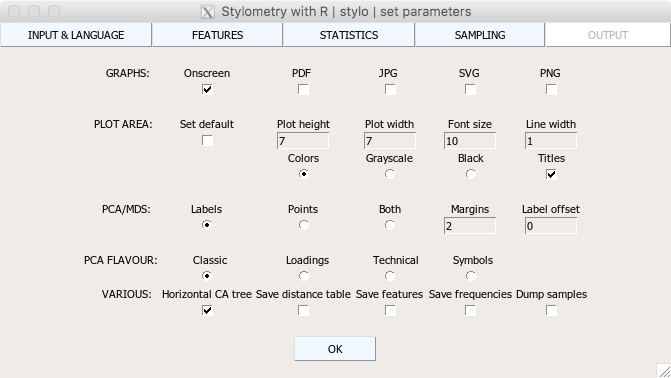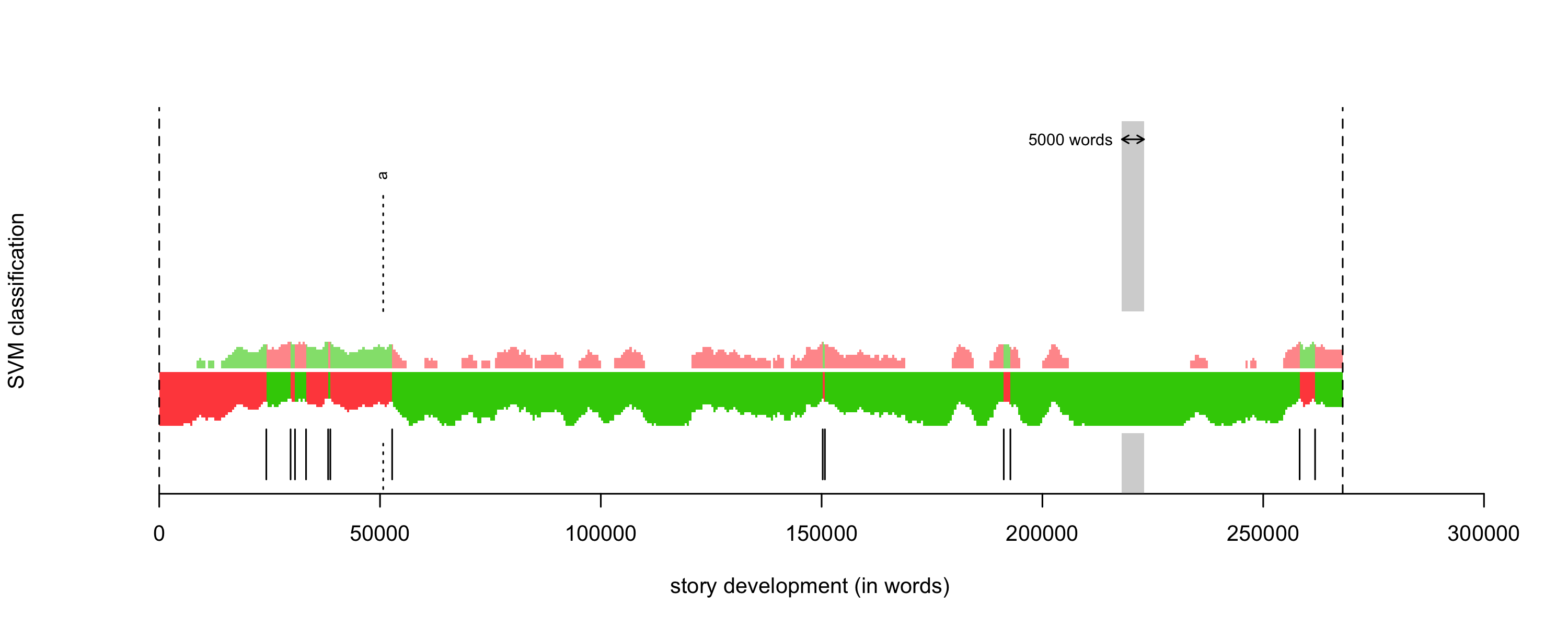Disclaimer
This crash tutorial introduces basic functions of the package stylo, in order to help the users start their experiments in no time. Essentially this means that no theoretical background will be provided. Also, the discussion on the functionalities of the package stylo will be reduced as much as possible. For more details, please refer to the following resources:
Installing stylo
- run R
- type
install.packages("stylo")
- pick your R server
- click
OK
- done!
Some basic R functions, just in case
- to activate a package:
library(stylo)
- to set working directory:
setwd("path/to/my/stuff")
- to find your current location:
getwd()
- to list files in your current location:
list.files()
- to get help:
help(<function>), e.g. help(stylo)
- to quit R:
q()
Main functions: stylo()
- It computes distances (differences) between texts, …
- … represented as rows of frequencies of most frequent words.
- Then it plots graphs of those distances:
- Cluster Analysis plots (dendrograms)
- Multidimensional Scaling scatterplots
- Principal Components Analysis scatterplots
- Bootstrap Consensus Trees plots (for multiple parameter settings)
- Bootstrap Consensus Networks (other software will be needed to take over)
- The plots can be both displayed on screen and saved to a file (e.g. PNG).
Functions: stylo.network()
- It is an extended version of the function
stylo().
- It performs Bootstrap Consensus Networks, or a network-like generalization of the Bootstrap Consensus Trees method.
- It produces interactive visualizations in a web browser: to make it happen, you have to install an additional R package first. Type:
install.packages("networkD3")
Main functions: classify()
- It trains a model for pre-defined groups of texts, e.g. authors.
- Then it computes distances (differences) between texts, …
- … represented as rows of frequencies of most frequent words.
- Finally, it compares the trained models with test texts, using:
- Delta classifier (lazy learner introduced by Burrows)
- k-NN classifier (lazy learner relying on >1 neighbors)
- Suppor Vector Machines, a high-performance non-probabilistic classifier
- Naive Bayes, a classical yet slightly outdated classifier
- Nearest Shrunken Centroids, a classifier for high-dimensional datasets
- A final report of the classifier’s performance is outputted.
Main functions: oppose()
- Designed to compare two (groups of) texts
- It cuts input texts into equal-sized samples
- Finds words characteristic for two (groups) of texts
- These can be reused with
stylo() or classify()
- Produces a diagram of the use of each group’s words
Functions: rolling.classify()
- Looks for traces of authors in a co-authored text…
- … by sliding through this text sequentially in order to detect peculiarities.
- Produces a graph of the respective strengths of these traces.
Functions: imposters()
- Performs a computation-heavy technique of authorship verification, referred to as the General Imposters method.
- It compares a disputed text against (a) some texts by a potential author of that text, and (b) several texts written by people who could not have written it (aka the imposters).
- In many random iterations it estimates if the text in question was more likely written by the candidate, or by any of the imposters.
Preparing a corpus
- before you launch R, …
- in your favourite folder, create a subfolder named
corpus
- put your raw text files there, e.g.:
Shakespeare_Hamlet.txtKyd_Tragedy.txt- etc.
- to be on the safe side - make sure your files are in UTF-8, especially if the language of your corpus contains diacritics!
Running stylo()
- activate the package
- type
library(stylo), hit ENTER
- navigate to your favourite folder:
- geeks:
setwd("the/path/to/my/favourite/folder")
- RStudio users: find your directory in the Files panel, then use Menu > More > Set as Working Directory
- Windows users: use Menu > File > Change directory
- MaxOS users: use Menu > Misc > Change working directory
- launch the main function:
stylo() parameters
- INPUT: state your texts’ format
- LANGUAGE: self-evident
- Don’t press OK yet!

stylo() parameters
- FEATURES: things to count: words or characters
- ngram size: say 1 for single features, 2 for 2-grams, etc. In a vast majority of cases, you’ll choose word 1-grams.
- MFW SETTINGS: how many most frequent words to use
- in most cases,
Minimum = Maximum

stylo() parameters
- CULLING: optionally, filter out some words you don’t want to analyze. Examples:
- 0 – all the words survive culling
- 20 – a given word has to appear in at least 20% texts
- 100 – an extreme filter: all words that don’t appear in all the texts are removed
- DELETE PRONOUNS: optionally, filter out personal pronouns.
- Attention! The set of pronouns is chosen according to the selected language
stylo() parameters
- STATISTICS: Cluster Analysis, Multidimensional Scaling, etc.
- DISTANCES: choose how the similarities between texts should be measured
- Classic Delta: perhaps a best choice to start
- Cosine Delta (aka Wurzburg Delta): perhaps an even better choice
- Eder’s Delta: a good choice for highly inflected languages

stylo() parameters
- SAMPLING: do I want to split the texts
- no sampling: the texts will be analyzed as they are
- normal sampling: dividing the texts into equal-sized blocks
- random sampling: randomly harvesting N words from each text
- number of samples: random harvesting can be repeated n times

stylo() parameters
- OUTPUT: most of the options are self-evident. Some might be useful:
- on screen: make sure that this is switched on to see your results
- PCA flavour: choose “loadings” to see the discrimination power of particular features (but first, choose PCA on STATISTICS tab)
- horizontal CA tree: use it to position your dendrograms horizontally

Bootstrap Consensus Networks
- There are two ways of computing a stylometric network:
- interactive:
- run the function
stylo.network()
- set the parameters as for Bootstrap Consensus Networks
- a web browser will start automatically: your network is there!
- static, yet highly customizable:
- run the function
stylo(network = TRUE)
- find a file named
..._C_0.5_EDGES.csv in your working directory
- load it into a network manipulation tool, e.g. Gephi
Running Gephi: Import
- select GEPHI > New Project
- Data laboratory > Import Spreadsheet
- Import settings:
- Separation: Comma
- As table: Edges table
- Charset: don’t bother if your filenames contain no fancy characters, e.g.
Brontë_Wuthering.txt; otherwise choose wisely
- Next
- Select ALL available options
- Finish!
Running Gephi: Labels
- We need to get authors’ names…
- Select Create column with list of regex matching groups > ID.
- Title: of your choice, e.g. Author,
- Regular Expression: limit what content to extract from the ID,
- e.g. to extract just the author from
Brontë_Wuthering.txt: ^[A-Za-z]+
- OK!
- Copy data to other column > Author to Label
Running Gephi: Overview
- Go to Overview panel
- In Appearance > Nodes > Partition
- Select Author
- Apply
- Show labels (T icon on the bottom panel)
Running Gephi: Overview Layout
- Select ForceAtlas 2
- If you have a lot of data:
- Dissuade Hubs
- Prevent Overlap
- Edge Weight Influence 0.5
- Scaling: 500
- Run!
Running Gephi: Overview Layout (cont.)
- To make labels align:
- If your nodes stick together:
- Run! (for Expansion - a couple of times)
Running Gephi: Preview
- Go to Preview panel
- Node labels
- Edges
- Thickness: play with 0.1, 0.01, etc.
- Refresh!
- Reset zoom
Running Gephi: saving a network
- File > Save
- Picture
- File > Export > SVG/PDF*/PNG
- For PDFs Options > Landscape & increase margins!
- OK!
Running oppose()
- Different subfolder structure:
primary_setsecondary_settest_set (optional)
- Running the function:
- What we get:
words_preferred.txt characteristic for the primary_set textswords_avoided.txt characteristic for the secondary_set texts
- word frequency graph
oppose() parameters
- Slice length: size (in words) of the samples (5000)
- Slice overlap: (0)
- Method: (Craig’s Zeta)
- Visualization: type of graph (Markers)
oppose() parameters
Most of the parameters for this somewhat underdeveloped function are not on GUI. You can switch them on as command line parameters
- when your corpus contains non-Latin diacritics:
oppose(encoding = "UTF-8", corpus.lang = "Spanish")
Running rolling.classify()
- Different subfolder structure:
reference_set (individual writings)test_set (collaborative text)
- Running the function:
library(stylo) - Example:
rolling.classify(write.png.file = TRUE, classification.method = "svm", mfw = 100, training.set.sampling = "normal.sampling", slice.size = 5000, slice.overlap = 4500)
Running rolling.classify()
How to read the output? Look at this example for “Roman de la Rose”:  Sections attributed to Guillaume de Lorris are marked red, and to Jean de Meun - green. The thickness of the bottom stripe indicates certainty of classification and a vertical dashed line the commonly-accepted division.
Sections attributed to Guillaume de Lorris are marked red, and to Jean de Meun - green. The thickness of the bottom stripe indicates certainty of classification and a vertical dashed line the commonly-accepted division.





 Sections attributed to Guillaume de Lorris are marked red, and to Jean de Meun - green. The thickness of the bottom stripe indicates certainty of classification and a vertical dashed line the commonly-accepted division.
Sections attributed to Guillaume de Lorris are marked red, and to Jean de Meun - green. The thickness of the bottom stripe indicates certainty of classification and a vertical dashed line the commonly-accepted division.